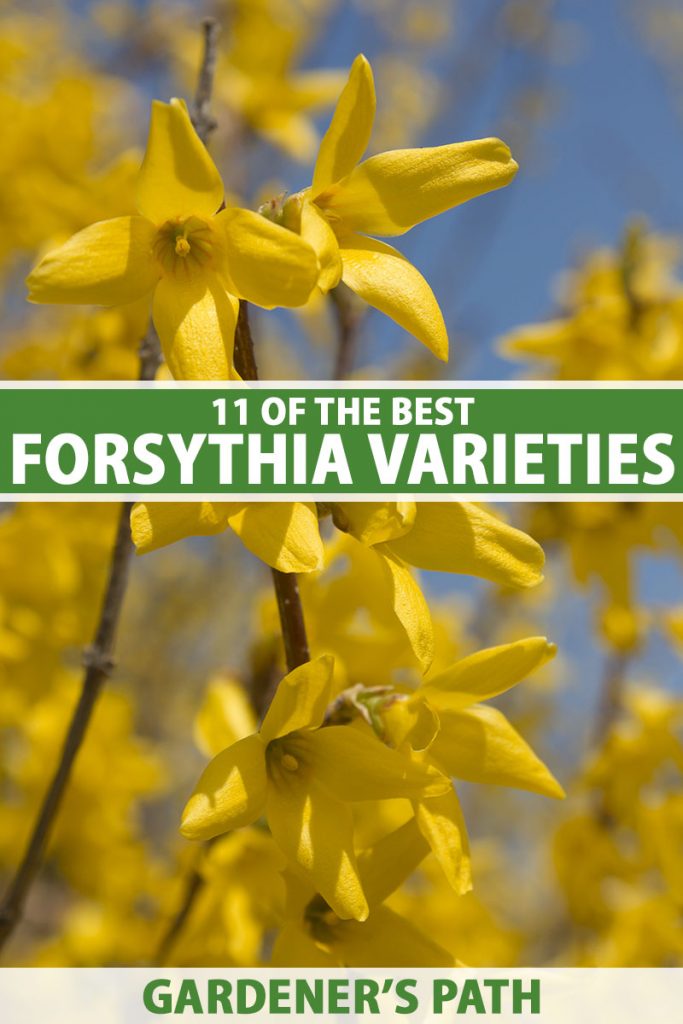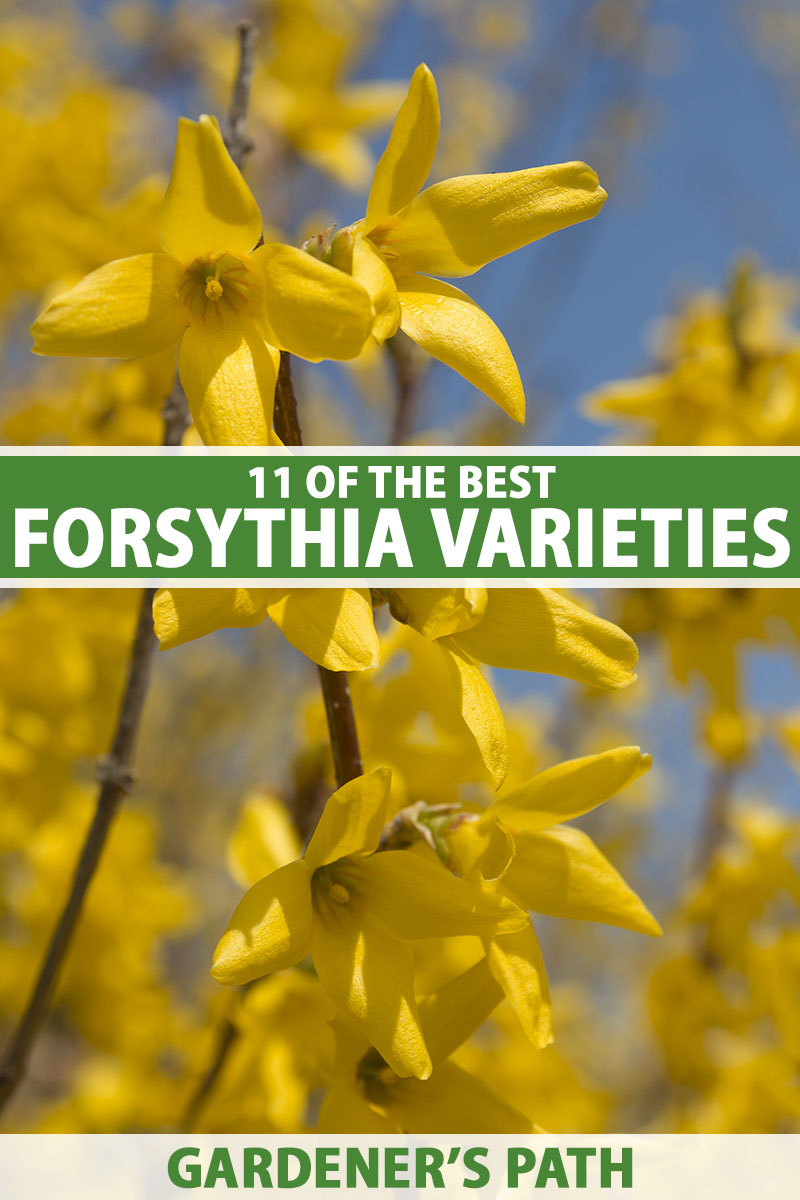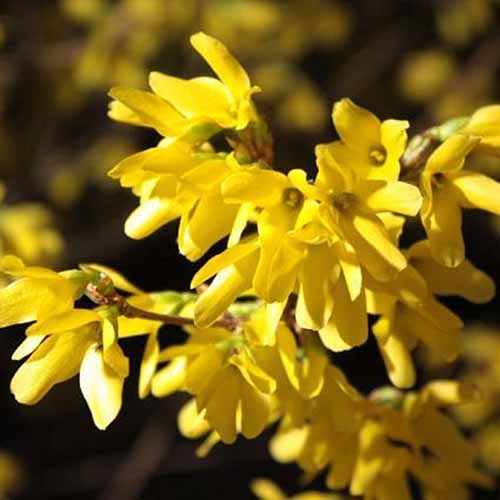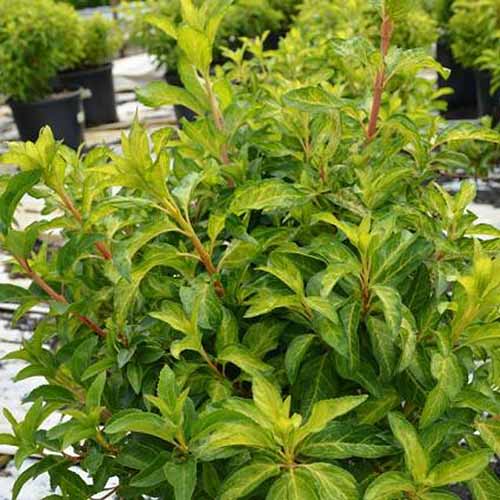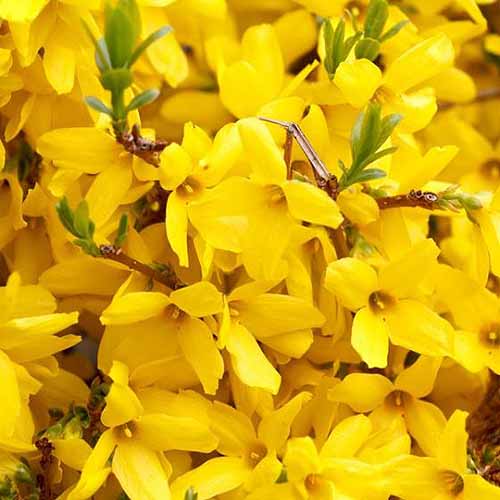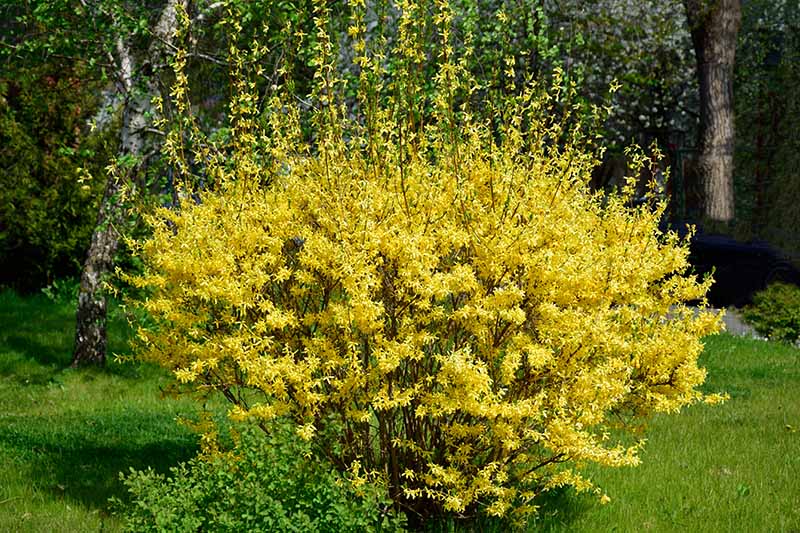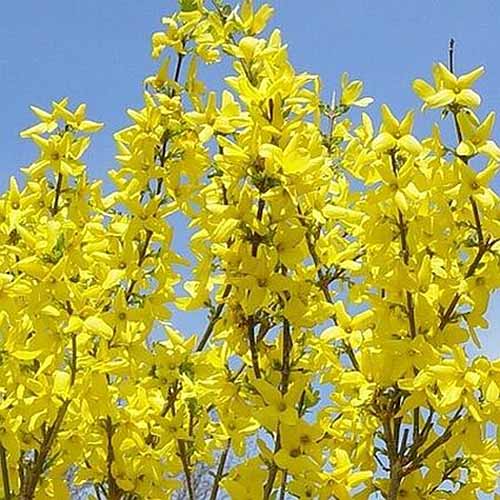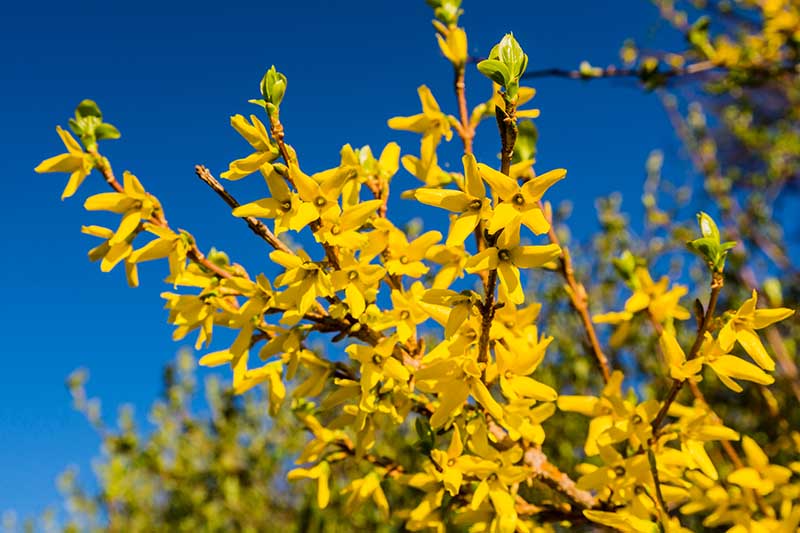There are 11 species in the Forsythia genus and numerous cultivated varieties that vary in height, growth habit, bloom time, and to some degree, color. In our guide to growing forsythia, we discuss all you need to know to successfully cultivate this sturdy, long-lived bush, suitable for USDA Hardiness Zones 5 to 8. It requires a full sun location and well-draining soil with a pH of 6.5 to 7.5. We link to vendors to help you find relevant products. If you buy from one of our links, we may earn a commission. Here’s the lineup: Our array of options ranges from dwarf to giant, and densely compact to airily weeping. Whether you want to create a forsythia hedge, or give free rein to a stand-alone specimen, you’re sure to find what you are looking for among our favorites.
1. Bronxensis
F. viridissima ‘Bronxensis’ is a dwarf variety with a low-profile height of two to three feet, and an equal spread. Its compact growth habit makes it well suited to container gardening. You can plant multiple specimens in close proximity to create rows of low, friendly hedges, or amorphous ground-covering drifts.
‘Bronxensis’ This cultivar is a late-spring bloomer with bright yellow flowers and leaves that turn bronze in the fall. You can find bare root stems or potted shrubs in #3 containers available from Nature Hills Nursery.
2. Citrus Swizzle
F. viridissima ‘McKCitrine’ aka ‘Citrus Swizzle’ is a variegated dwarf forsythia that grows to a petite 18 to 24 inches tall and wide, making it perfect for smaller containers, as well as bed and border edging. Plant it as a texturally-rich ground cover and enjoy ever-enlarging drifts of lemon yellow in springtime. The foliage is uniquely variegated, displaying shades of chartreuse and lime green that age to light green and cream, and finally, blush to burgundy at season’s end.
‘Citrus Swizzle’ Unlike many other forsythia plants, this type is prized for its foliage rather than its small yellow blooms. You can find ‘Citrus Swizzle’ plants in #3 containers available at Nature Hills Nursery.
3. Fiesta
F. x intermedia ‘Fiesta’ is a compact hybrid cultivar with a mature height of approximately three feet and a width of four feet. It’s one of the earliest bloomers, frequently coloring in late winter. The foliage is variegated in shades of light green and yellow to cream. It has red stems that are especially eye-catching in winter when they are leafless.
‘Fiesta’ Expect armloads of gold-colored blooms as spring gets underway. The foliage may shade toward gold and purple when the growing season draws to a close. You can find ‘Fiesta’ available in #3 containers from Nature Hills Nursery.
4. Gold Tide® Courtasol
F. x intermedia Gold Tide® ‘Courtasol’ is a small-stature hybrid with heights of 24 to 30 inches and a width of four feet. This cultivar is also known as ‘Maree D’Or’ and was the recipient of the Royal Horticultural Society Award of Garden Merit in 2002.
Gold Tide® ‘Courtasol’ Mass plant in sunny woodland settings, and along foundations and walkways, for broad, low-profile expanses of lemon-yellow springtime color. Fall foliage may take on hues of gold or purple. You can find bare roots and plants in #3 containers available at Nature Hills Nursery.
5. Intermedia
Also known as border forsythia, the Forsythia x intermedia hybrid – a cross between F. suspensa and F. viridissima – is appreciated for its tall height, rounded shape, delicately arching branches, and vivid flowers in early spring.
It’s also the parent plant from which a number of different cultivars are bred. Heights range from eight to 10 feet, and widths from 10 to 12 feet. This tall type makes an excellent informal hedge or privacy screen. It also performs well as a stand-alone specimen in an expansive naturalized setting. Leaves may shade toward gold or purple in the fall.
6. Kumson
The green leaves of F. viridissima var. koreana ‘Kumson’ are accented by contrasting veins in shades of cream and cold that create the illusion of silver filigree. Leaves turn bronze in autumn and stems of purplish-brown are striking when leafless in winter and laden with gold in early spring. ‘Kumson’ Expect a mature height and width of four to six feet. Growth is upward and arching, for naturalistic, informal privacy hedges, stand-alone specimens, or mixed shrub groupings.
7. Lynwood Gold
F. x intermedia ‘Lynwood Gold’ reaches heights of six to eight feet with a spread of eight to 10 feet, and has an upward, branching growth habit. You can create privacy around a property perimeter, or plant as an imposing stand-alone specimen that welcomes spring with voluminous quantities of bold blossoms.
‘Lynwood Gold’ Foliage may shade toward gold and purple in autumn. Find ‘Lynwood Gold’ in quart-size containers or as bare roots available at Nature Hills Nursery.
8. Magical® Gold
F. x intermedia Magical® ‘Gold’, aka ‘Kolgold’, is an early-blooming type with modest dimensions of three to four feet tall and wide. Unlike many varieties, this cultivar blooms on both old and new wood, and provides masses of golden color on its upright branches. Foliage bronzes to golds and purples in the fall.
Magical® ‘Gold’ It’s best suited to planting as low friendly hedges, mixed shrub groupings, and stand-alone placements. You can find potted starter plants available from Burpee.
9. Meadowlark
F. x ‘Meadowlark’ is one of the most cold-hardy late winter to early spring choices. It’s a hybrid cross between F. ovata and F. europaea, and is hardy as far north as Zone 3. It is densely branched and reaches impressive heights of eight to 10 feet with an equal spread.
‘Meadowlark’ ‘Meadowlark’ makes a spectacular privacy hedge, windbreak, or stand-alone, with its thicket of stems. Enjoy masses of bright yellow in the spring and foliage that shades to purple in the fall. You can find bare root stems available at Nature Hills Nursery.
10. Show Off® Mindor
F. x intermedia ‘Mindor’ is an early spring flowering shrub that has dense, upright branches. An abundance of bright yellow flowers are followed by deep green leaves that turn burgundy as autumn rolls around.
Show Off® ‘Mindor’ With heights and widths of five to six feet, its vertical growth habit and compact form makes it well suited to close planting for hedging. You can find ‘Mindor’ in quart-sized or #2 containers available at Nature Hills Nursery.
11. Sunrise
Known as “semi-compact,” F. x intermedia ‘Sunrise’ is a late winter to early spring selection with upright branches and a mounding growth habit. This cultivar is hardy to Zone 4.
‘Sunrise’ Its airy nature and four- to six-feet height make this an attractive choice for stand-alone or mixed shrub group placements. Foliage deepens to purple hues in autumn. You can find bare root plants available at Nature Hills Nursery.
What’s Not to Love?
Although I tend to favor native plants, I like non-native forsythia because it’s a part of my family’s gardening culture. As a matter of fact, it’s so prevalent in my region that at one time I thought it was native to Pennsylvania.
For me, the first sighting of yellow brings a sense of giddy anticipation of the gardening season to come, and a welcome sense of having weathered another winter. I also like forsythia because it is so user friendly. Simply snip a stem and push it into the soil, or bend a branch to the ground and cover it with a rock, and nine times out of ten, roots will sprout. With its tolerance for poor soil and pollution, forsythia is a useful choice for locations where erosion is a problem, as well as in urban settings. And finally, in addition to the wealth of flowers in springtime, these fast-growing, sturdy, long-lived shrubs offer an early nectar source to native bees, as well as year-round habitat for small wildlife, like birds. It’s time to pick your favorites: Will it be petite specimens for patio pots, mid-size bushes for mixed shrub groupings, or behemoth 10-footers to screen your property from the highway? We can’t wait to hear about them in the comments section below! And for more information about growing forsythia in your garden, you’ll enjoy reading these articles next:
7 Tips for Growing Formal and Informal Forsythia Hedges 5 Tips for Pruning Forsythia 7 Reasons Why Forsythia May Not Bloom 5 Common Causes of Forsythia Yellowing
© Ask the Experts, LLC. ALL RIGHTS RESERVED. See our TOS for more details. Product photos via Burpee, DAS Farms, and Nature Hills Nursery. Uncredited photos: Shutterstock.
